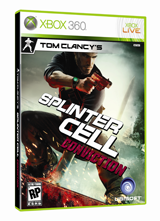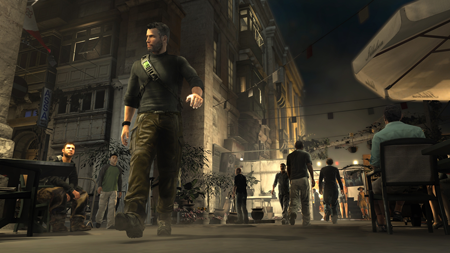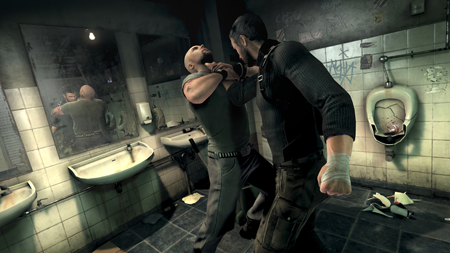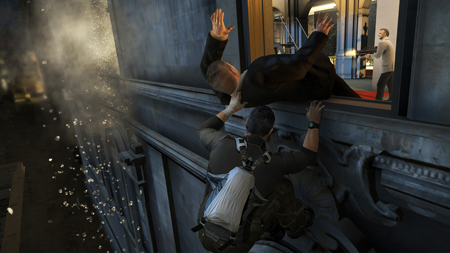Tom Clancy’s Splinter Cell: Conviction – Xbox 360 review
Review by Johnus Maximus
 Sam Fisher, the poster-boy for stealth shooters is back, this time he’s out for personal revenge on the people responsible for killing his daughter. Released for Xbox 360 and coming soon to PC, players once more take control of gravel-voiced Fisher as he uncovers a web of intrigue and betrayal.
Sam Fisher, the poster-boy for stealth shooters is back, this time he’s out for personal revenge on the people responsible for killing his daughter. Released for Xbox 360 and coming soon to PC, players once more take control of gravel-voiced Fisher as he uncovers a web of intrigue and betrayal.
In an effort to reach a larger audience Ubisoft Montreal have departed somewhat from the traditional Splinter Cell formula. While some fans may be upset, those unfamiliar with the series will find it an accessible, if somewhat convoluted, initiation into this shadowy world.
Splinter Cell games have always been about achieving your goals using stealth, the cunning and physical dexterity of Fisher himself along with the advanced technology available to him courtesy of black-ops department Third Echelon. It has been a critically successful series of games of which Conviction is the sixth.
Hoping to expand their audience, the creators have taken influence quite clearly from action films of recent times, there is more than a hint of Jason Bourne, Jack Bauer and Daniel Craig’s Bond in this title. Rather than spending time planning your moves and eliminating enemies with efficiency, you instead rely more on brute force and adapting to the events as they unfold.
There is a powerful story to be told, fugitive Fisher must rise up against Third Echelon, the secretive government organisation that once held him in esteem to discover who is behind his daughter’s death, before finding himself embroiled in a wider plot that could end up with the death of a United States president.

With his gun holstered, Sam does not cause concern amongst a crowd
Unfortunately, the story is not told particularly well, so although your objectives are clear in each level, it’s extremely difficult keeping track of who is betraying who, what they have done and why I should care. Occasional flashbacks and flash forwards only serve to increase this confusion. I did find the projected storytelling a neat touch, during the various brutal interrogation sequences, imagery supporting the dialogue is projected onto walls, trucks or other nearby scenery.
This augmented reality gimmick is also used to display your mission objectives, and it’s a nice touch that allows you to fluidly progress without having to interrupt the game with visits to a menu screen for clarity. Another new, and possibly the most interesting feature in Conviction is the “mark and execute” function, which allows you to plan a series of kills and can be instantly unleashed with the tap of a button. You must perform one hand-to-hand takedown before you can do this though, so it forces you to use a little bit of stealth rather than going in all guns blazing.
As you have no real technological assistance for a large part of the game, Sam has to rely on making himself invisible to the enemies by hiding in areas with no light. To inform the player that they are hidden, the game switches the colour palette to monochrome, which detracts immensely from the gritty and realistic environments that have been built for this game.

Interrogation sequences allow you to choose which parts of the environment to use against your enemies
If you’ve played any of the previous Splinter Cell titles, you’ll know how relentlessly difficult some of the enemies can be, for Conviction the enemy AI has been dumbed down significantly and they pose no real challenge unless you play it on the hardest skill setting. You no longer have the ability to drag dead bodies away so as not to alert suspicion, but this is usually fine as the enemies are more often than not oblivious to the corpse of their friend they have just walked past.
Sometimes this can create hilarious scenarios, like pulling six guards off a ledge and letting them plummet to their death in quick succession, but it can also cause some frustration as you attempt to make use of the “last know position” feature. Once a guard manages to spot Fisher, if you successfully slink out of sight, a silhouette appears outlining where the enemy believes you to be. When it works you can pull off some excellent flanking manoeuvres, grabbing guards from behind to use as human shields, or simply snapping their necks before finding another darkened corner to stalk from.
Eventually, the story allows Fisher to get hold of some of his fabled gadgetry, remote mines and an explosive sticky camera allow you to cause deadly diversions, flash bang grenades and a portable EMP device allow you to stun your foes in order to escape a situation that is escalating beyond control. Also, his trademark trifocal goggles have been now been changed into sonar goggles, showing up enemies in a phosphorus glow against a sea of grey static.

Removing an enemy by snatching him out of a window is great fun
It doesn’t take very long to reach the conclusion of the single player campaign, approximately six to eight hours in all, and although there are moments of excellence throughout, the poor storytelling, clumsy AI and the overall sense of style over substance lead me to feel dissatisfied.
Fortunately, there are some redeeming qualities to experience, in the form of an excellent co-operative and versus mode. The co-operative campaign takes place prior to the events of the single player, and you and a friend play as Archer and Kestrel, black ops agents from American and Russian organisations. You must work together to infiltrate secure areas, eliminating threats and interrogating people for information.
From the start you are equipped with a wide range of gadgets and the strategy you must adopt for success is much more like the traditional Splinter Cell games. Being able to split up and approach a situation from different angles allows a much more strategic way of playing. Also, using the mark and execute function in tandem with your partner allows you to take down a room full of guards in the most spectacular manner.

Fortunately, only Sam can see the projected objective, otherwise the enemies would know his plan from the offset
There is also a standalone mode called Deniable Ops, in which you can once again assume the role of Archer or Kestrel, and select any of the co-operative levels to play in, but this time setting challenges like surviving waves of enemies or clearing out an area in the quickest time possible. You can play these modes with a friend, or if you just want to practice you can play by yourself.
Completing certain sub-challenges as you play the game awards you points with which to unlock weapon, gadget and armour upgrades. These upgrades apply in both campaigns and the deniable ops mode and some of the challenges are particularly tricky and can give even the most ardent Splinter Cell fan a run for their money. Despite the fun and exciting nature of the co-op mode, it is lacking in longevity.
I think this title is an excellent way of inducting people unfamiliar with stealth shooters, but ultimately I don’t feel there is enough here to satisfy existing fans. Had it contained a more cohesive and thrilling storyline it would have scored higher, as it stands Tom Clancy’s Splinter Cell: Conviction scores four out of five stars.
